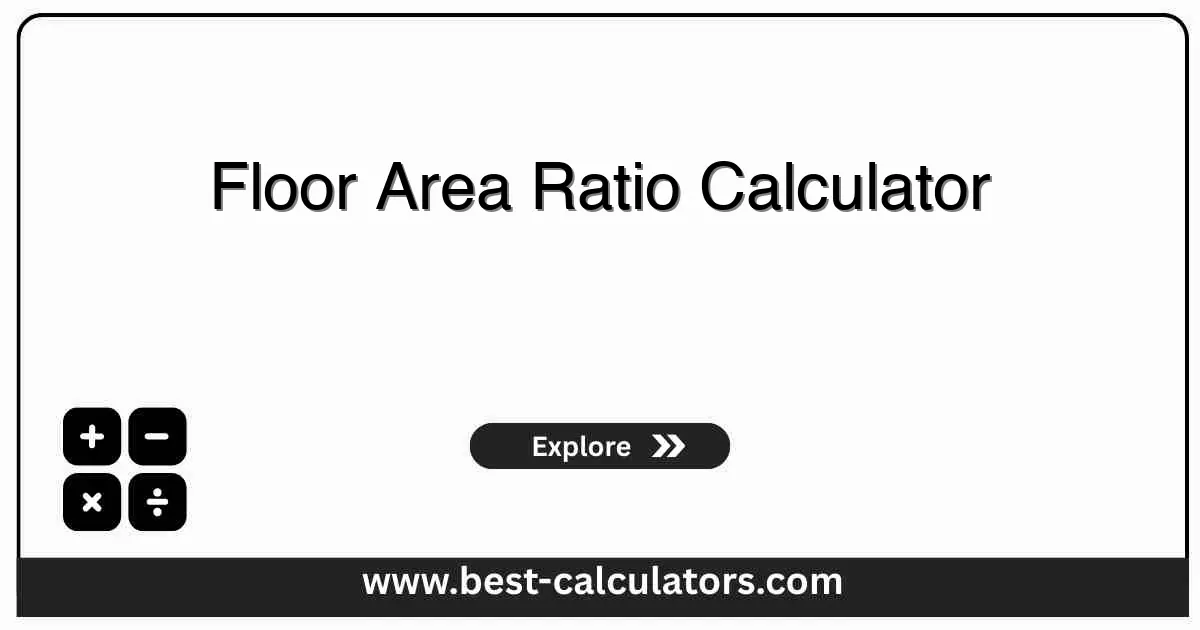Floor Area Ratio Calculator - Calculate FAR & Density
Calculate the Floor Area Ratio (FAR) or Floor Space Index (FSI) to analyze building density, assess zoning compliance, and maximize land potential.
Area Inputs
Results
What is Floor Area Ratio (FAR)?
Floor Area Ratio (FAR), also known as Floor Space Index (FSI), is a crucial zoning tool used by city planners to control the size and density of buildings relative to the land size. It acts as a multiplier that dictates how much square footage can be built on a specific plot.
FAR is not just about height; it combines height and footprint. A plot with an FAR of 1.0 allows you to build a 1-story building covering the entire lot, or a 2-story building covering half the lot. It provides flexibility in design while maintaining a consistent density cap for the neighborhood.
Common applications include:
- Zoning Compliance: Ensuring new developments meet municipal density codes.
- Investment Feasibility: Calculating the maximum sellable area for a development project.
- Urban Planning: Balancing infrastructure capacity with population growth.
To calculate the accurate square footage of individual rooms for your GFA total, use our Square Feet Calculator.
If you are estimating construction costs based on floor area, try our Home Renovation Cost Estimator.
For estimating wall materials for your approved building envelope, use the Drywall Calculator.
If you are planning the foundation for your new footprint, our Concrete Calculator is essential.
For projects involving parking lots or driveways to meet zoning, check the Asphalt Calculator.
How It Works
The calculation is a simple ratio of building mass to land area:
Example Scenarios for a 10,000 sq ft lot:
- FAR 0.5: Max buildable area is 5,000 sq ft (e.g., one 5,000 sq ft house).
- FAR 1.0: Max buildable area is 10,000 sq ft (e.g., a 2-story building covering 50% of lot).
- FAR 5.0: Max buildable area is 50,000 sq ft (e.g., a 10-story building covering 50% of lot).
Key Concepts Explained
Gross Floor Area (GFA)
The sum of the floor areas of all stories of a building, measured from the exterior faces of exterior walls.
Lot Coverage
The percentage of the lot covered by the building footprint. A high FAR on a small footprint means a tall building.
Setbacks
Mandatory distances from property lines where you cannot build. These limit your footprint, often forcing vertical growth.
Air Rights
Unused FAR can sometimes be sold to adjacent properties in dense urban zoning districts.
How to Use This Calculator
Enter Floor Area
Sum up the area of every floor in your building. Check local codes for exclusions like basements.
Enter Lot Area
Input the total land area of the property parcel from your survey or deed.
Calculate
Click to see the FAR ratio and density classification.
Analyze
Compare the result against your local zoning code maximums.
Benefits of Calculating FAR
- • Maximize Value: Determine if a property is "underbuilt" and has potential for expansion or additional stories.
- • Zoning Safety: Ensure your dream home design doesn't violate city density laws, preventing costly redesigns.
- • Comparison Tool: Quickly compare the density of different potential development sites before purchasing.
Factors Affecting Your Results
Exclusions
Parking structures, mechanical penthouses, and basements are often excluded from GFA, allowing you to build "more" than the FAR suggests.
Bonuses
Some cities offer FAR bonuses for including public amenities like plazas, affordable housing, or green building features.

Frequently Asked Questions (FAQ)
Q: What is Floor Area Ratio (FAR)?
A: Floor Area Ratio (FAR) is the relationship between the total amount of usable floor area that a building has, or has been permitted to have, and the total area of the lot on which the building stands.
Q: How is FAR calculated?
A: FAR is calculated by dividing the total gross floor area of all buildings on a lot by the total area of the lot. Formula: FAR = Gross Floor Area / Lot Area.
Q: What is the difference between FAR and FSI?
A: They are effectively the same thing. FAR (Floor Area Ratio) is commonly used in the US, while FSI (Floor Space Index) is used in other parts of the world like India. Both measure building density.
Q: Does floor area include basements?
A: It depends on local zoning ordinances. Often, basements and parking garages are excluded from FAR calculations, but you must check your specific local regulations.
Q: What does a high FAR mean?
A: A high FAR indicates a higher density of construction, such as urban skyscrapers or apartment complexes. A low FAR typically indicates low-density suburban or rural development.